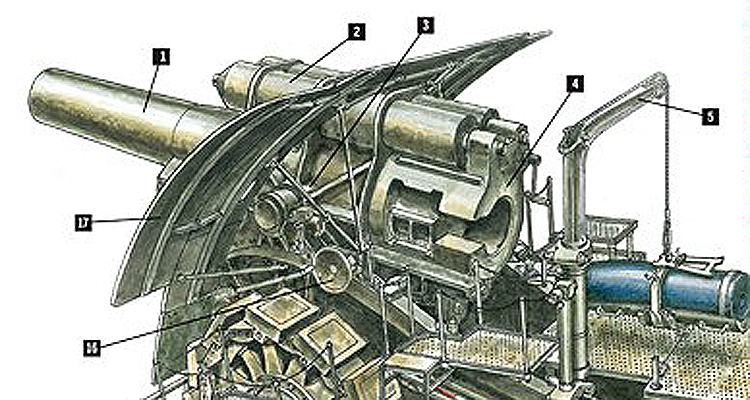
42cm M-Gerät
Caliber: 42cm (16.5 inches)
Dimensions: 10 meters long (32 feet 10 inches), 4.7 meters wide (15 feet 5 inches), 4.5 meters high (14 feet 8 inches)
Weight: 42,600 kilograms (47 tons)
Barrel length: L/12 (5 meters/16 feet 5 inches)
Max. barrel elevation: 65 degrees
Max. range: 9,300 meters (5.8 miles)
Rate of fire: Eight rounds per hour
Contributing to the late-19th century arms races that led to the outbreak of World War I was the dual advancement of artillery-resistant fortifications and artillery capable of breaching them. In response to the construction of fortress rings—such as those in Liège and Namur, Belgium; Verdun, France; and Przemysl, in Russian-occupied Poland Germany’s Krupp firm set out to develop increasingly large and powerful siege mortars and howitzers. The culmination of those efforts was the 42cm M-Gerät Minenwerfer (“mine thrower”).
Starting in 1893, when France and Russia signed their military alliance, the German army’s Artillerie-Prüfungskommission (APK) and Krupp had produced and tested a series of giant siege mortars, starting with the 30.5cm (12-inch) Beta-Gerät. Weighing more than 33 tons—four times heavier than any other artillery piece in the army—the Beta Gerät had to be broken down, transported in railcars to the staging area and then emplaced on a prepared piece of flat ground. In 1907 Krupp started manufacturing wheeled-carriages that allowed steam-powered tractors to pull the guns along roads and across solid terrain. Finally, in 1911 Krupp rolled out the 42cm M-Gerät, a 47-ton howitzer on a two-wheeled carriage, which could be moved in five pieces.
The APK ordered its first M-Gerät in July 1912, and by the time war broke out in August 1914, the German army had 18 various guns in 10 siege batteries, including the Küstenmörser (“coastal mortar”) Battery 3 with two 42cm M-Geräts. Its destructive power compelled the garrison of Liège’s Fort Pontisse to surrender on August 13. Two days later the gun’s crew obliterated Fort Loncin with 25 shells in two hours, thus intimidating the garrisons of adjacent Forts Hollogne and Frémaille into surrendering without a shot fired.
While the 42cm M-Gerät accomplished what it was designed to do—reduce Allied fortresses—its mobility remained limited, and only the stalemate on the Western Front perpetuated its usefulness as a weapon. Still, the Germans’ nickname for it, “Dicke Bertha”—allegedly in reference to Frau Krupp—gave it concurrent notoriety among the Allies as “Big Bertha,” a term later applied to any extraordinarily large artillery piece.





